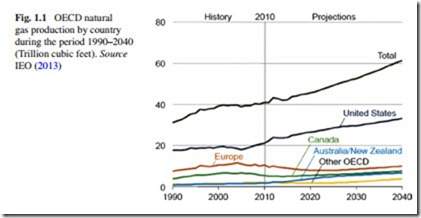Coal
The mix of primary fuels used to generate electricity has changed a great deal over the past four decades on a worldwide basis. Despite of these changes, coal continues to be the fossil fuel most widely used for electricity generation, except in the Latin America and the Caribbean region, although the generation of electricity using natural-gas-fired power plants grew rapidly during the past 30 years. At the same time, the use of oil for electricity generation has been declining since the mid-1970s, when oil prices rose sharply. High fossil fuel prices recorded between 2003 and 2013, combined with concerns about the environmental consequences of greenhouse gas emissions, have renewed interest in the development of alternatives to fossil fuels, specifically renewable energy sources for electricity genera- tion. In the IEO (2013) report, long-term prospects continue to improve the role of renewable energy sources in electricity generation, supported by government incentives and by high fossil fuel prices.3
In 2007, coal-fired generation accounted for 42 % of world electricity supply; in 2035, its share is expected to increase slightly to 43 %; this means an increase of only 1 % in the whole period. Sustained high prices for oil and natural gas make coal-fired generation more attractive economically, particularly in nations that are rich in coal resources, but the negative effect that the burning of coal has on the environment and the possibility of introducing certain energy policies to reduce or limit the growth of greenhouse gas emissions to the atmosphere should have a negative impact on the use of this type of energy source for the generation
of electricity in the future. This new policy could reduce the participation of coal in the energy mix of several countries during the coming years. Despite of this situation, world net coal-fired generation is expected that nearly doubles over the period 2007–2035, from 7.9 trillion kWh in 2007 to 15 trillion kWh in 2035.
In 2020, the participation of coal in electricity generation is expected to be 40 %; this means 2 % lower than the level reached in 2007. In 2035, the participa- tion of coal in electricity generation is expected to be 43 %; this means 3 % higher that the level reached in 2020, and 1 % higher than the level reached in 2007. In general, the use of coal in the European region (OECD countries4) will drop from around 19 quadrillion Btu in 1980 to a little bit higher of 10 quadrillion Btu in 2035.
Nevertheless, coal is expected to be the second fastest growing sources of energy for electricity generation in the projection period, but this projection could be altered substantially by any future national policies or international agreements that aim to reduce or limit the growth of greenhouse gas emissions to the atmos- phere. It is expected also that coal continues to be, during the coming years, the fossil fuel with the largest share of worldwide electric power production by a wide margin (see Fig. 1.1).
Undoubtedly, the electric power sector offers some of the most cost-effective opportunities for reducing carbon dioxide emissions in many countries,5 and this is something that politician and energy experts should have in their minds during the consideration of what could be the best composition of the energy mix of their countries in the future. Coal is both the world’s most widely used source of energy for power generation and also the most carbon-intensive energy source. If a cost, either implicit or explicit, were applied to carbon dioxide emissions, there are sev- eral alternatives no- or low-emission technologies that currently are commercially proven or under development, which could be used to replace some coal-fired power plants. Implementing these new technologies would not require expensive, large-scale changes in the power distribution infrastructure or in electrical equipment.
